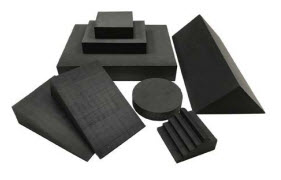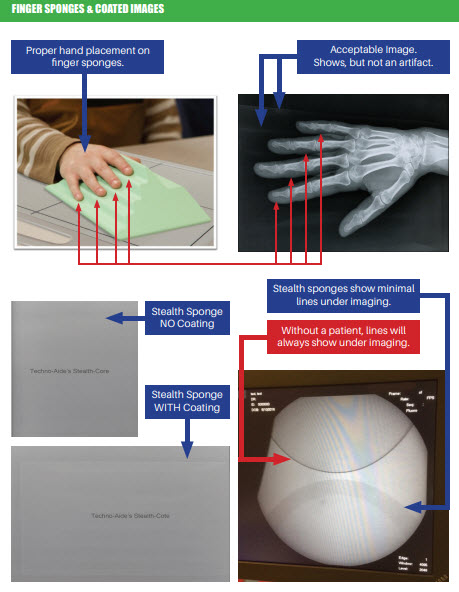Closed Cell Positioning Sponges FAQ

We now offer over 30 standard closed cell sponges in the most popular shapes and sizes to fit almost any need! Shop our enormous inventory of individual sponges and kits! Here is everything you need to know about our revolutionary closed cell sponges!
Features:
- Artifact free - 100% radiolucent
- Extreme durability - Lightweight and comfortable
- Cleanable, non-porous surface
- Anti-Microbial and Anti-Fungal material
- Will not absorb liquids even if torn or damaged
NEW closed cell crosslink foam positioners have a very fine micro-cellular structure that has a compact feel and are resistant to fluids. The smooth, easy to clean surface is resistant to blood, Betadine, barium, alcohol, and other fluids. This specialty foam will not absorb any liquids, even if torn!
Our proprietary manufacturing process provides a unique finish that is aesthetically pleasing and provides the necessary support for patient positioning. No coating is required and sponges are a neutral charcoal gray color.
Closed cell sponges are radiolucent, ensuring x-rays will pass through the sponge and not be blocked. When used correctly under normal imaging technique, no other sponge offers as many benefits.
Our sponges are ozone resistant and Anti-microbial; antibacterial and anti-fungal. Making them impervious to mildew, mold, rot and bacteria. Nontoxic and contain no CFC’s, HCFC’s or hydrocarbon blowing agents. This product is not classified as hazardous under OSHA regulations.
We offer both 2 lb and 6 lb density foam options. 2 lb density foam is recommended for majority of of applications. 6 lb density foam is recommended for weight bearing applications.
We recommend storage of closed cell positioners indoors, in a clean dry area and away from excessive heat, ignition sources and oxidizing agents. Surface can be cleaned with cold water and mild detergent immediately after contact with fluids. PDI Sani-cloth AF3 alcohol free Germicidal wipes can be used to disinfect surface. Harsh abrasive chemicals are not recommended. Do not autoclave, launder, or submerse sponges in water.Sponges can oxidize when exposed to fluorescent light, sunlight and heat sources.
Frequently Asked Questions:
1) My facility requires coated sponges. Do closed cell sponges have a coating? Closed cell sponges don't need a protective coating! The foam is non-porous, meaning it will not absorb liquid. Coated sponges need a "coating" because the inside or "core" is a standard, porous sponge.
2) Will closed cell sponges show artifacts under x-ray? No, they won't! Extensive testing has shown that closed cell sponges are completely radiolucent and artifact free! Since closed cell does not require a chemical coating (see question 1), the edges will not show as an artifact under xray!
3) Can I clean and sanitize closed cell sponges in-between use? Yes, you can! You can clean closed cell foam just like a coated sponge. Any standard, non-bleach-based cleaning solution your facility currently uses will work! Techno-Aide also offers numerous recommended cleaning solutions and accessories.
4) Why do closed cell sponges sometimes look used or scuffed? The manufacturing process for closed cell foam is very different than a traditional coated sponge. Coating is typically a chemical solution sprayed over a piece of foam (see question 1). This process creates an even and smooth surface. Closed cell sponges do not require coating to be non-porous. Without a coating, the outer layer can show smudges, nicks and other surface marks. We do not sell used sponges. Your closed cell sponge will always be brand new!
5) Why would I want closed cell instead of a coated sponge? Closed cell sponges offer ALL of the benefits of a coated sponge and none of the drawbacks! Anytime you apply coating to a sponge, the sponge will show during imaging. It is important that technologists understand the difference between shadowing and artifacts. Shadowing happens when an item shows under imaging but does not create an unacceptable image. Artifacts occur when a positioning aid shows under imaging and disrupts the image taken. For example, say you were imaging a patient's hand they slammed in a car door. If you placed their hand on the edge of a rectangular sponge to image it, you will more than likely see a line from the outer edge of coated sponge cut through the image of the hand. This is an artifact and an unacceptable image. If you used a hand sponge for the same image, if an artifact were to show through the forearm, this is an acceptable image. Since the forearm is not the extremity being imaged. Closed cell sponges do not create artifacts, so you never have to worry about an unacceptable image! Closed cell sponges are also easy to clean, highly durable and sometimes cost less than a coated sponge! Closed cell sponges offer every benefit of a coated sponge with none of the drawbacks or concerns.
6) Closed cell sounds too good to be true. Why do people still use coated sponges? Until recently, closed cell foam manufacturing was a very specialized and expensive process. Techno-Aide has helped innovate new and more efficient ways of manufacturing. This has allowed us to offer closed cell options cheaper than ever! This year we introduced our first stocked closed cell sponges and kits, and we are adding more every day

Positioning Sponges
Before you can understand and properly use positioning aids, you need to understand what the “field of view” for imaging is. Understanding the field of view is critical when using positioning aids properly.
When a technologist needs to take an image, positioning sponges are used for generally two purposes:
First is comfort and support for a patient while imaging a specific body part. Imagine if a patient was in a car accident and broke their hand. You need to take an image of the damaged hand. However, the patient’s arm is badly scrapped or cut and they are extremely sore or bleeding.
In order to position the patient properly, safely and comfortably, you may use a positioning sponge to prop up their arm. Since you are imaging only the hand, this sponge is not in the field of view. Because of this, it does not matter if this sponge is radiolucent or if it will show in an image. The sponge (if coated) is protected from the bodily fluids and can be wiped clean after use.
The other purpose is positioning of the actual body part in the image. Let’s say you need to image the hand of the patient in the car accident. However, the hand is so badly damaged that you cannot spread the fingers apart properly to get the angles needed. You may use a sponge to rest the patients hand on during the procedure. The angles or “steps” of a hand sponge will help spread the fingers and position them properly for the image. Since this sponge is in the field of view, it is extremely important that the sponge be radiolucent and will not show an artifact.
Different sponges are designed for these specific purposes.
Now that you understand what the field of view is, you need to understand an artifact. An artifact is anything that shows on an image that distorts or disrupts the image of the body part being examined. This is NOT to be confused with a sponge showing outside of the body part.
Using the damaged hand as an example again: If the hand is shown in the image and the only part of the sponge you see is the outer border (passing through the wrist or arm), this is not an artifact. This is considered an acceptable image.
Since the sponge only shows through a part of the body NOT being examined, it is not considered an artifact. It is ONLY when a line or mark shows THROUGH the body part or extremity being imaged that it is considered an artifact.
Artifacts are different than shadows. Shadows may occur with any sponge. However, a sponge will instantly show on an image if it has any sort of coating. A coated or vinyl covered sponge will show shadowing on any image. The chemical composition of coating and the thickness/material of vinyl shows during imaging. However, shadowing does not make an image unacceptable.
As mentioned before, it is ONLY when a line or mark shows through the specific body part being examined that it is an unacceptable image.
Coated Sponges VS Non-Coated Sponges
A non-coated sponge is simply a bare piece of sponge cut into a particular shape. Think like a standard kitchen sponge. No coating, porous (absorbs liquid) and not very durable. These types of sponges exist because some use and some facilities require nothing more than a basic piece of sponge. Most doctors’ offices will rarely ever have a need for a positioning sponge. Since it is not a high commodity, they order basic (non-coated) sponges to keep costs as low as possible.
Some facilities and usage require protecting the sponge from absorption of liquids and bodily fluids. In the rare time that a doctor in a small practice uses a sponge and the patient bleeds on it, that sponge needs to be disposed of and they would have to order a new one. ANY TIME you apply coating to a sponge it will show up under x-ray. The chemical coating reacts with the imaging to show under x-ray. The higher the Kv applied to an image, the more you will see. A true technologist will know this and understand the proper levels of Kv to apply to an image. They are taught these concepts in school.
Hospitals (and some other facilities) absolutely require all positioning aids meet sanitary guidelines. In order to meet this standard, there are typically three types of positioning sponges that a hospital (or any place determined by regulations) can order:
First are coated sponges. These are standard sponges coated with a protective chemical surface. The chemical surface preserves the pliability (flexibility) of the sponge but creates a non-porous surface. These can be wiped clean and are sanitary to use repeatedly. However, the outer coating is simply a chemical film. Under enough pressure or certain types of impact, the coating can rip and tear.
Second are vinyl covered bolsters. These are firm foam shapes covered with a heavy duty, vinyl material. These positioners are extremely durable with a cleanable, non-porous surface (think like a boat seat). Techno-Aide currently offers completely sealed seams on our bolsters. Other manufacturers use “hook & loop” connections to close the vinyl over the foam. Though this will seal over the foam, it is not 100% sanitary like our bolsters are. The hook & loop is not a sealed edge and liquid can absorb into the foam. The vinyl will also show seams under imaging. As I explained before, it all depends on the type of imaging as to the need for this type of product.
Finally (and top recommendation) are closed cell sponges. These are relatively newer on the market. These are positioners made from a low density, non-porous, highly durable foam. Think like a high-quality pool noodle that didn’t absorb any water. The density of the foam is so high that this foam does not require any coating to be non-porous and durable. These sponges are 100% radiolucent and will not show up under x-ray. These are the absolute best options for any use in imaging. If they are or are not in the field of view is irrelevant since they are completely radiolucent.
